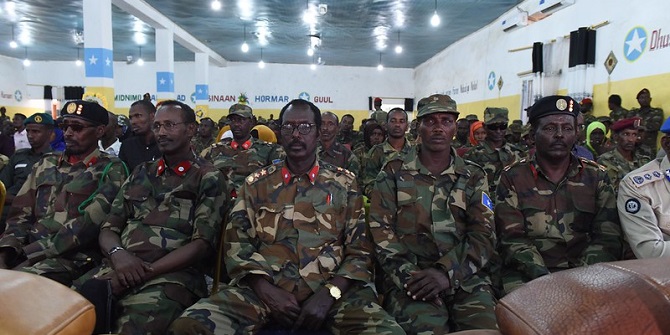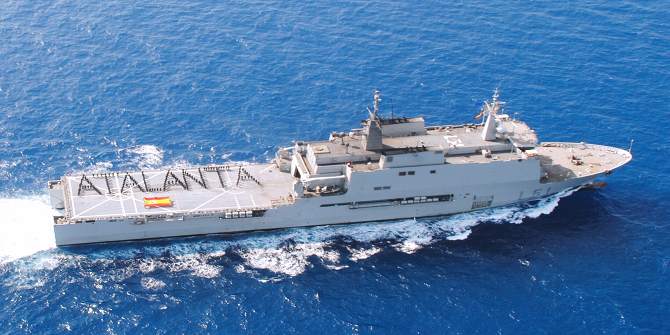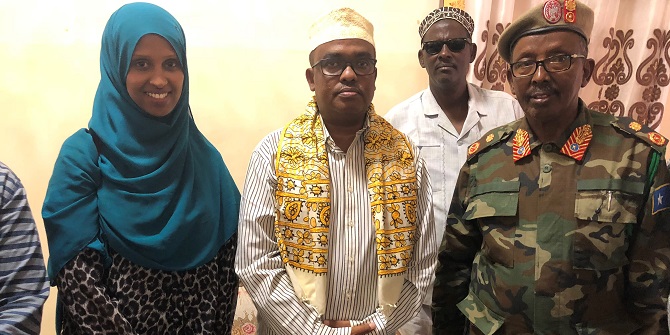
The political marketplace in Somalia is as much internationalised as it is internalised. The War on Terror spearheaded by the United States to target actors and institutions that facilitated the airplane attacks on New York and Washington in September 2001 has added to the fragmentation of Somalia. The ’War on Terror’, dragged Somalia in as proxy players, and produced local opportunistic actors in the form of militia operating in the political marketplace. Somalia has been a fragmented country since the late 1980s, when the (still ongoing) civil war destroyed the existence of the post-colonial Somali state. In the early 1990s, the United States tried but failed miserably in its ‘New World Order’ for Somalia. The New World Order meant the post-Cold War Somalia should be restructured along the Western interests. The American-led Operation Restore Hope culminated in the infamous ‘Black Hawk Down’ incident in October 1993, in which the American forces were dragged in the streets of Mogadishu by angry Somali mobs, after which the US withdrew its forces from Somalia.
No war can be waged without some form of a local power base, and several secular and religious groups established themselves in the shadow of the struggle against insurgent movements, like Al- Shabaab. One such crucial group was the Ahlu-Sunna Wal Jameeca (hereafter Ahlu-Sunna), a politico-religious armed group in Central Somalia funded by external patrons. Its sudden fall earlier this year after clashing with forces of the Federal Government of Somalia makes the historical assessment of Ahlu-Sunna’s evolution and aims timely.1
Ahlu-Sunna was structured like Huthis group in Yemen. Based in specific towns in Central Somalia populated by specific clans (the Eyr/Habargidir, Surre/Dir and Marehan), the group gained prominence in parallel with the Washington-sanctioned Ethiopian invasion of southern Somalia in December 2006. The invasion was specifically aimed at eliminating the power of the Union of the Islamic Courts (UIC) that challenged the American, as well as Ethiopian interests in the Horn of Africa.
The political marketplace in Somalia has then become internationalised. Both the United States and Ethiopia sought supportive local militia for the UIC invasion.The UIC, however, had previously entered into a series of armed confrontations with warlords who had divided up the Somali capital city of Mogadishu and created economic-generating fiefdoms with their own makeshift airports (like Ballidoogle, Dayniile, Esaleey, Jasiira and Number Konton or No. 50) and seaports (like Merka and El Ma’an [Sweet Well]).
The warlords, who had been on the CIA payroll for some time – widely known at the time but later exposed in Wikileaks cables – failed to countenance the UIC. Ahlu-Sunna was not a credible presence at the time so it was Ethiopia’s Meles Zenawi to take the task of facing the UIC.2 The Ethiopian forces were successful to not only crush and fragment the UIC in December 2006, but also to expel most of its core leadership from Somalia by January 2007.
Between 2006 and 2009, the political dynamics of southern Somalia morphed from a narrow clan confrontation into a front in what was represented as global jihad. As expected by most observers of the Somali conflict, the victorious Ethiopians met stiff resistance from the wider Somali population who viewed the Ethiopian invasion through the historical lenses of the traditional enmity between Somalis and Ethiopians that dated back to the sixteenth-century, when a creative local Muslim leader Ahmed Gurey led Somalis along with other Muslim ethnicities of the Horn against the encroaching Christian Ethiopia, then known as Abyssinia.
The United States sought to reduce the religious-nationalist narrative of anti-Ethiopian expansionism that painted the war as one between the oppressed Muslim Somalis versus the oppressive Christian Ethiopians.3 The CIA redirected its financing of the warlords to fund Ahlu-Sunna militias in support of the demoralised Ethiopian forces. The Ahlu-Sunna leadership was assisted in maintaining their militia to fight alongside the Ethiopian invaders as an auxiliary force against the resisting UIC remnants like Al-Shabaab. While Ahlu-Sunna believed in a mystic pacifist sect of Sufi Islam, Al-Shabaab (and most of the UIC members) held a purist militant Islam of Salafism.4 The facilitation and funding of Ahlu-Sunna by the Ethiopian military intelligence and the CIA in the midst of a proxy war was reported by human rights organisations as the worst that Somalia had ever seen since the Siad Barre regime in the 1980s. This was a turning point for the group whose sole purpose initially was to counter the emergent insurgent group of Al-Shabaab.5
With the approval of the United States and Ethiopia, the Ahlu-Sunna militia took to rule the zones in Central Somalia vacated by the UIC, such as Dhusamareb and Guri’el. Before the Ethiopian invasion, Dhusamareb and Guri’el had been important political centres, but not military posts, for the UIC. Colonel Sheikh Hassan Daher Aweys, the powerful spiritual leader of the UIC, made his base in Guri’el (from where his kin originated) well before the UIC’s emergence as a powerful group in February 2006. From his base in Guri’el at the height of the UIC power in June 2006, he acted as another Ayatollah Khomeini and would meet high-level western diplomats in order to negotiate on behalf of the UIC. BBC Somali Service also interviewed him from there in July 2006 after meeting an Italian envoy. It was after the UIC defeat by the Ethiopian forces at the end of 2006 that Dhusamareb and Guri’el fell under the Ahlu-Sunna militia and became permanent centres for the group. By 2008, Ahlu-Sunna had made several quick (but temporary) successes at seizing other towns of Central Somalia like Abudwaak and Adaado.
The Ahlu-Sunna leaders such as Sheikh Mohamed Shaakir Ali Hassan and the movement’s spiritual leader Sheikh Mo’allim Mohamud Sheikh Hassan used the external resources to consolidate power and build a powerbase, concentrating military operations in Central Somalia, today known as Galmudug. Ahlu-Sunna, which had long obtained arms equipment and other supplies from Ethiopia, and had been financially supported by the CIA and through other channels, became auxiliary forces in the US counter-terrorism activities in conflict-ridden Somalia. Recent research into Ahlu-Sunna has related the group to the wider geopolitical dynamics it had found itself enmeshed in during the post-UIC period.6
Both the US and Ethiopia have used the group for not just particular military purposes to fight Al-Shabaab, but also other important aspects, such as information-gathering. For example, Ahlu-Sunna shared vital information about Al-Shabaab activities in Central Somalia with the US and Ethiopia. This led to the capture and elimination of many hardcore Al-Shabaab elements, some of which were clandestinely operating in Central Somalia.
With the external resources accumulated from more than a decade at its disposal, Ahlu-Sunna emerged as a power to be reckoned with when it comes to the political marketplace of Somalia.7 But over time both the United States and Ethiopia stopped their support of Ahlu-Sunna, including with the change of leadership in Ethiopia more recently. The discontinuation of external sources forced Ahlu-Sunna to seek a local patron – that is, the current regime in Mogadishu. This proved to be a miscalculated decision on the part of its desperate leadership and something that hastened its downfall. The Mogadishu regime entered into exhausted negotiations, including offers of money and power positions for Ahlu-Sunna leadership. All these were empty promises which resulted in a trap that ended their influence after they fled their main stronghold Dhusamareb.
Ahlu-Sunna reached accords with past Somalia regimes and then left them alone when the said accords did not suit the individual interests of its main leadership. Indeed, the Ahlu-Sunna acted in its own interests as a player in the political marketplace right from the start, regardless of its dependence on external support, but it never acted without an external patron, either regionally or globally. Ahlu-Sunna was both a political marketplace player and also a proxy for Ethiopian and US interests in Somalia, particularly the counter-insurgency operations of the war on terror. Ahlu-Sunna illustrates perfectly that Somali politics is part of a broader global pattern, as well as locally part of the broader domestic politics of the political marketplace. Will Al-Shabaab follow in the footsteps of Ahlu-Sunna? Time will tell.
1 Abdulaziz Osman, ‘Somalia’s Sufi Muslim Leaders Surrender to Government’, VOAnews.com, 29 February 2020.
2 WikiLeaks Document: ‘Somalia – Ahlu Sunnah Wal Jama [sic] and TFG Support’, 8 June 2009.
3 Mohamed Haji Ingiriis, ‘The Invention of Al-Shabaab in Somalia: Emulating the Anti-Colonial Dervishes Movement’, African Affairs, 117, 467 (2018), 217-237.
4 Ibid.
5 Human Rights Watch, “So Much to Fear”: War Crimes and the Devastation of Somalia (New York: Human Rights Watch, 2008); and Human Rights Watch, Shell-Shocked: Civilians under Siege in Mogadishu (New York: Human Rights Watch, 2007).
6 Giulio. Di Domenicantonio, ‘“With God on Our Side”: A Focus on Ahlu Sunna Waljama’a, a Sufi Somali Paramilitary Group’, The Annual Review of Islam in Africa, Issue No. 12/13 (2015-2016), 64-69.
7 WikiLeaks Document: ‘Somalia – Ahlu Sunnah Wal Jama [sic] and TFG Support’, 8 June 2009.
Note: The CRP blogs gives the views of the author, not the position of the Conflict Research Programme, the London School of Economics and Political Science, or the UK Government.





